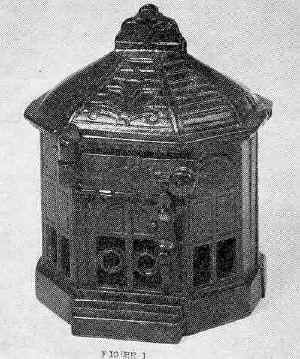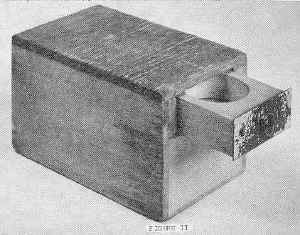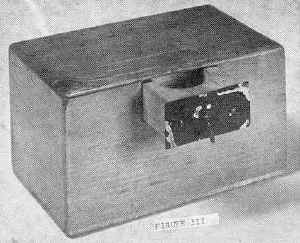Snap It Bank and
Trick Savings Bank (Type I and Type II)
by F.H. Griffith - HOBBIES Magazine - August, 1975
 Not too often, but now and then, we run into a mechanical bank
about which there just isn’t too much to be said. It is usually a very simple type
mechanical with very little action. Well, at this point we are faced with not one, but
three mechanicals that come into this category. Numerically classified, they are Snap It
Bank, No. 250 — Trick Savings Bank, Type I, No. 251 — Trick Savings Bank, Type
II, No. 252.
Not too often, but now and then, we run into a mechanical bank
about which there just isn’t too much to be said. It is usually a very simple type
mechanical with very little action. Well, at this point we are faced with not one, but
three mechanicals that come into this category. Numerically classified, they are Snap It
Bank, No. 250 — Trick Savings Bank, Type I, No. 251 — Trick Savings Bank, Type
II, No. 252.
The Snap It Bank, Figure 1, is cast iron with an overall japanned type finish. It’s sort of a nice little building type bank with a pivot drawer in the top front. The knob of the drawer is pulled and when open it is held in position by a small locking lever under the drawer. Place a coin on the drawer, push the locking lever, and the drawer snaps shut depositing the coin inside the bank. It is pictured in several trade catalogs of the 1885 to 1890 period, along with a number of H. L. Judd banks, and we are reasonably sure it too was made by Judd.
 The Trick Savings Banks are wood with tin front facing on the
drawers. They are pictured Type I (end drawer), Figure 2, and Type II (front drawer),
Figure 3. The operation of each is the same, pull the wooden drawer open and a round
recessed section is exposed. Place the coin in the round section and close drawer. On
re-opening the drawer, the coin has disappeared. The drawer has a trick bottom pivoted at
the front that allows the coin to slide into the bank. To remove coins, turn the bank
upside down which allows a drop pin in the back of the drawer to release the drawer from
the bank. Coins are shaken out from the drawer space and then the drawer replaced with
drop pin in position.
The Trick Savings Banks are wood with tin front facing on the
drawers. They are pictured Type I (end drawer), Figure 2, and Type II (front drawer),
Figure 3. The operation of each is the same, pull the wooden drawer open and a round
recessed section is exposed. Place the coin in the round section and close drawer. On
re-opening the drawer, the coin has disappeared. The drawer has a trick bottom pivoted at
the front that allows the coin to slide into the bank. To remove coins, turn the bank
upside down which allows a drop pin in the back of the drawer to release the drawer from
the bank. Coins are shaken out from the drawer space and then the drawer replaced with
drop pin in position.
Paper labels were originally on the underside of all Trick Savings Banks as they told the story. The Type I shown, Figure 2, has the original label intact and we quote as follows:
TRICK SAVINGS BANK
This bank should be opened
by skill and not by force
TRY IT
Patented May 24, 1892 by C. Tollner
 So that’s it for three rather simple action, but still rather
interesting mechanical banks. Oh yes, we should mention that the finish on the Trick
Savings Banks is a clear or light color type varnish. The wood is very smooth and would
seem to be basswood. Charles Tollner, by the way, was from Pulaski, N.Y.
So that’s it for three rather simple action, but still rather
interesting mechanical banks. Oh yes, we should mention that the finish on the Trick
Savings Banks is a clear or light color type varnish. The wood is very smooth and would
seem to be basswood. Charles Tollner, by the way, was from Pulaski, N.Y.
